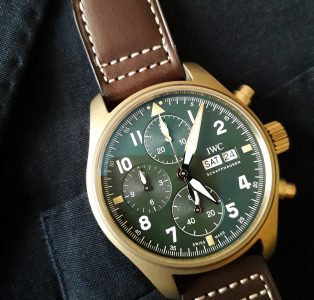Silver Spitfire Begins Journey
I first wrote about this iconic watch series a few months ago after attending the IWC Silver Spitfire event at Goodwood in April, in conjunction with a Members Meeting for historic racing cars. I have now attended the second event in August and so now cover/update some aspects which were touched upon in the earlier report.
Firstly, this event mainly focused on the preparation and actual take-off of the MkIX Silver Spitfire on its epic 27,000 mile journey around the World. I drove down early in the morning from Windsor in fog, low cloud and rain, and as such was very concerned that the whole thing may be called off. However, by late morning the clouds passed and bright sunshine shone down. There were several Spitfires in attendance (which you could get close to and chat to the pilots) and the overall scene – including the IWC “fair” (with live band, bars, food stalls and of course a watch boutique) which was great. Another thrill was to see a WW2 P-51 Mustang and Harvard fly in.
In the Boultbee Flight Academy’s hanger there was a stage set up and a historian gave a very interesting talk on the whole Spitfire story – and the great R J Mitchell who designed it. What a man! Despite being operated on in 1933 for bowel cancer, he continued working on the prototype – which flew successfully from Eastleigh in Hampshire in March 1936. By this time though he was pretty unwell and tragically died the following year aged only 42. Mitchell was an unassuming man and few knew how ill he was until near the end. Another incredible fact: He designed his own colostomy!!
Whilst in the hanger I had the opportunity to chat again to one of the two pilots, Steve Boultbee Brooks. I asked him few technical questions about the plane, which has been completely rebuilt. As the name suggests, the camouflage paint was not re-applied, but instead the aluminium panels were highly polished. Aside from looking fantastic, it actually saves quite a few pounds in weight and reduces friction. Extra fuel tanks have been added – one more in the fuselage and two in the wings in lieu of the 8 x 0.303 Colt-Browning machine guns. This more than doubles the original range to somewhat over 800 miles. The engine is to essentially original specification, however, some internal components have been made a little stronger. Other than some navigation and safety kit, its just about the same as when it flew in anger. I must admit that Steve seemed pretty calm, bearing in mind all the publicity and the looming enormity of what was required.
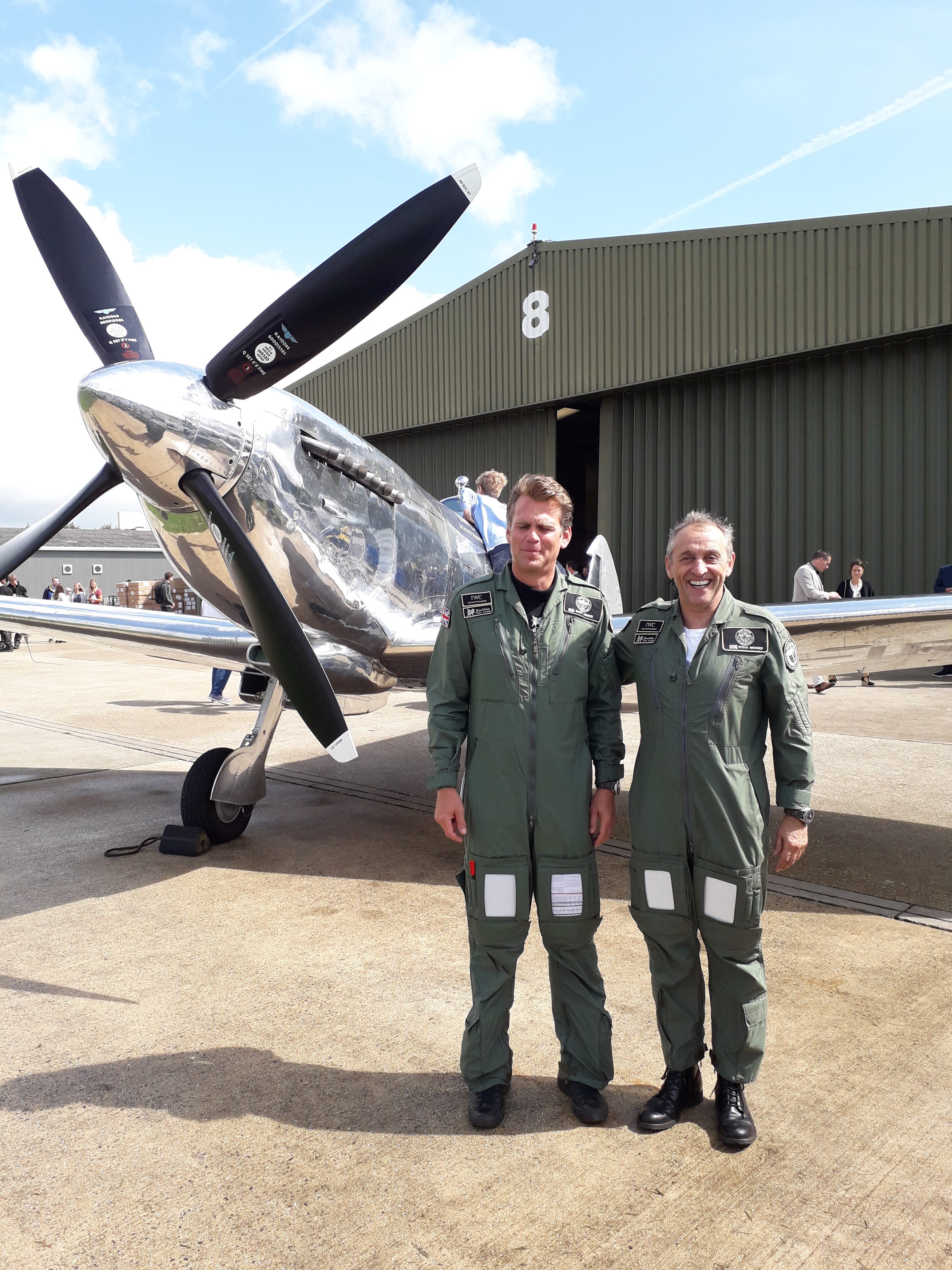
After generally milling about and chatting to people (some I knew a little, like Wei Koh from Revolution, but others I did not), and having a few snifters and some grub, it was time for the Red Devils to do their display. I had chatted to three of them earlier in the day when the weather looked doubtful and found out that they needed at least 1500 ft under any cloud to do their thing. The team is around 8 in number – although they never officially confirm numbers in case not all jump for some reason. The display was wonderful, with leg flares trailing red white and blue trails, and the last man trailed a huge Union Jack. All came down in a very controlled manner and landed beautifully within a short distance of each other.
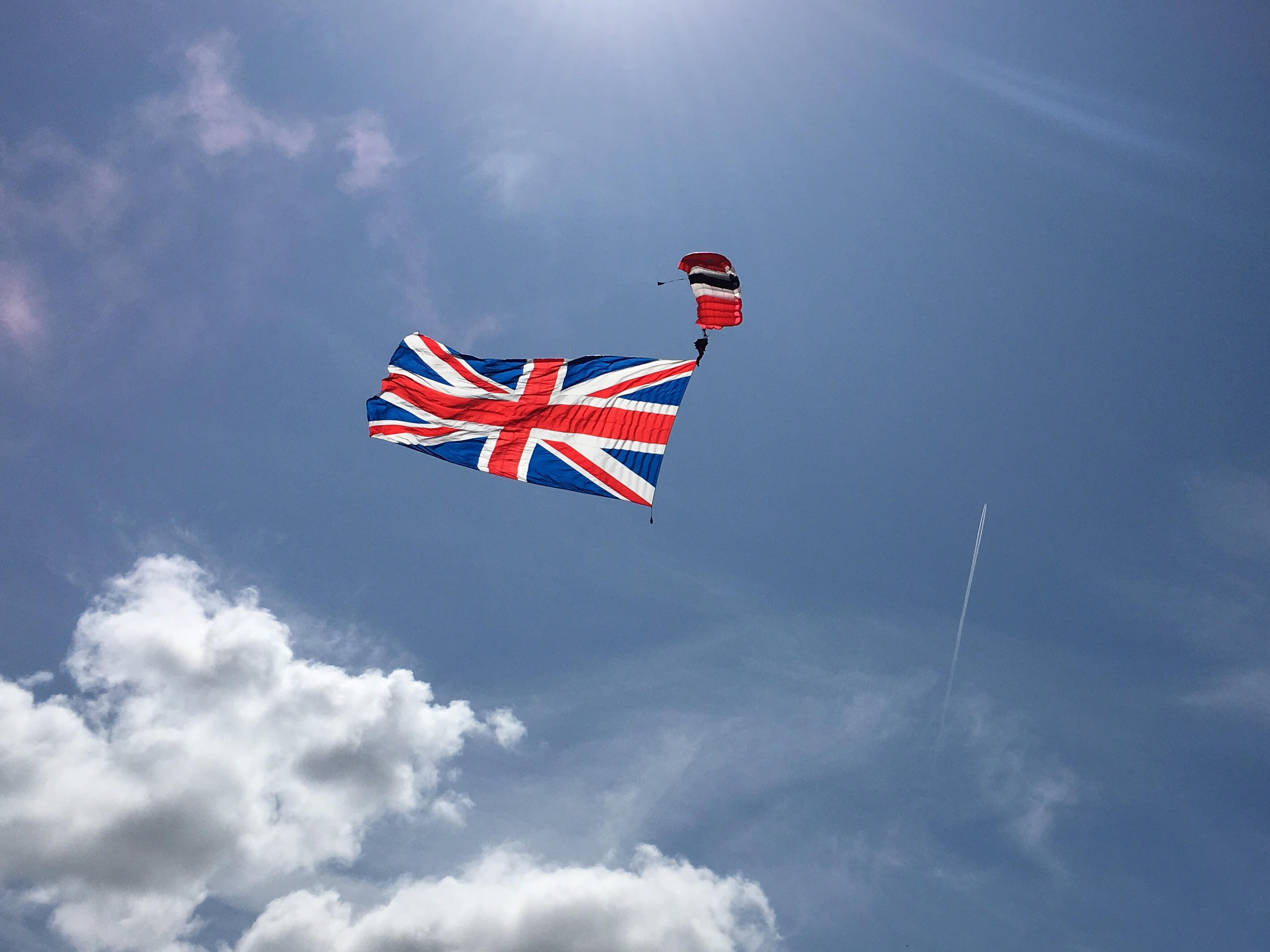
By around 1.30 the main event had arrived – the big take off! Everyone pressed forward to get a better view – watch enthusiasts, journalists, plus some of the IWC brand ambassadors such as; Rosamund Pike (very tall and elegant in a split length dress), David Coulthard, Taron Egerton and Dermot O’Leary. The Silver Spitfire took off first – closely followed by the trio of it’s other siblings, all doing a full lap before heading off on the first stage to Scotland. I don’t mind admitting that it was an emotional experience. For those interested, just Google Silver Spitfire and you can see the various ways you can monitor the plane’s progress, but to date all seems well.
Pilot’s Watch Chronograph Spitfire – Bronze – Reference IW387902
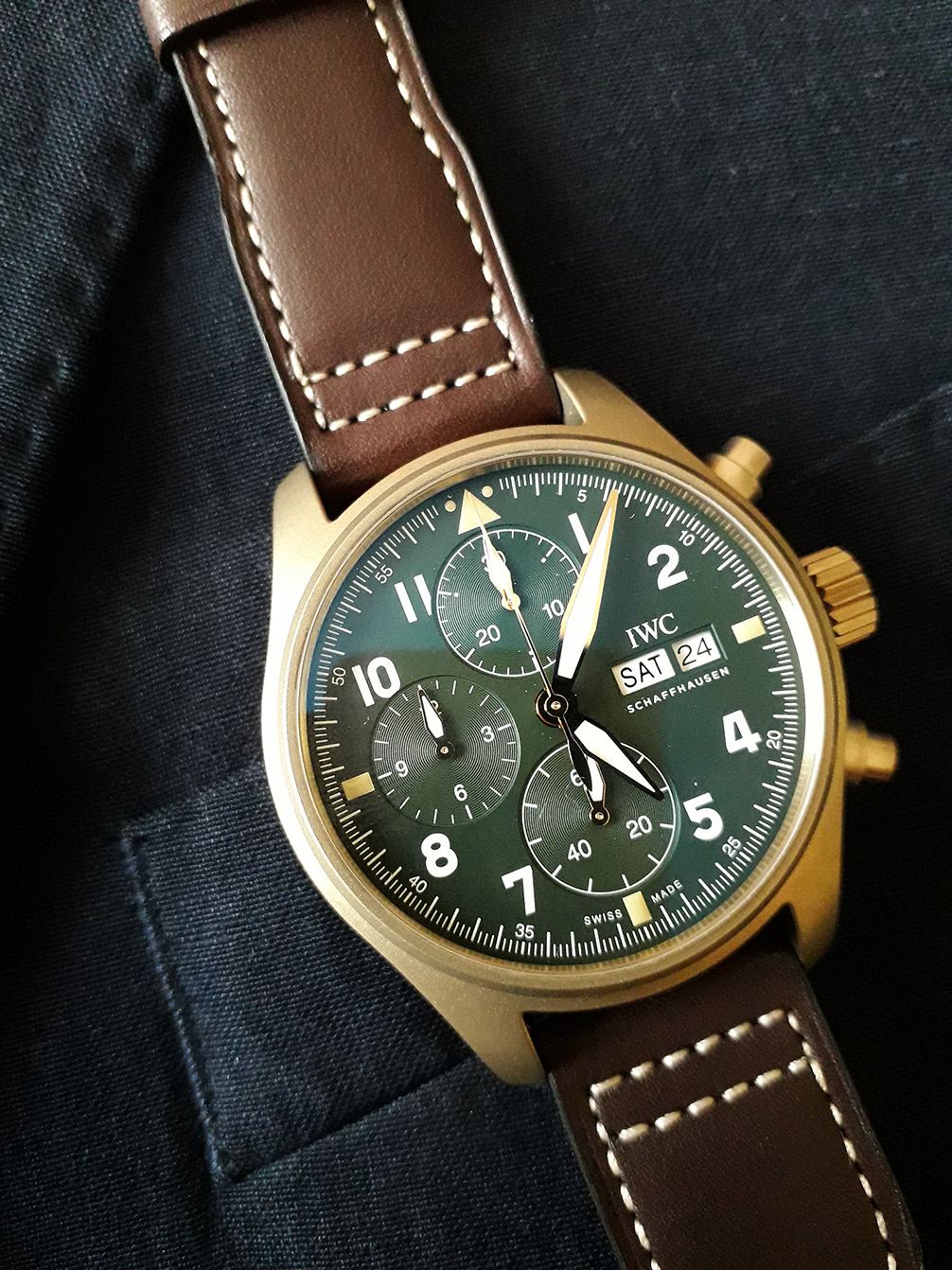
I touched upon this in my earlier article so shall not reprise entirely. At that time, I had not physically seen the bronze version, only the steel one, but as mentioned then I was very taken with the images I had seen. I had been told that the bronze version would not be available in the UK until October and even then supplies would be meagre as, although not a limited edition as such, IWC had decided to, well, slow production.
A little later I found myself in the pop-up boutique and was chatting with some of the IWC staff, including Simon the UK Sales Director. My eye then espied the watch in one of the glass cabinets. I liberated, examined from all angles, and then put on. I was not disappointed at all. It wears much the same as my ref IW371704 so felt familiar.
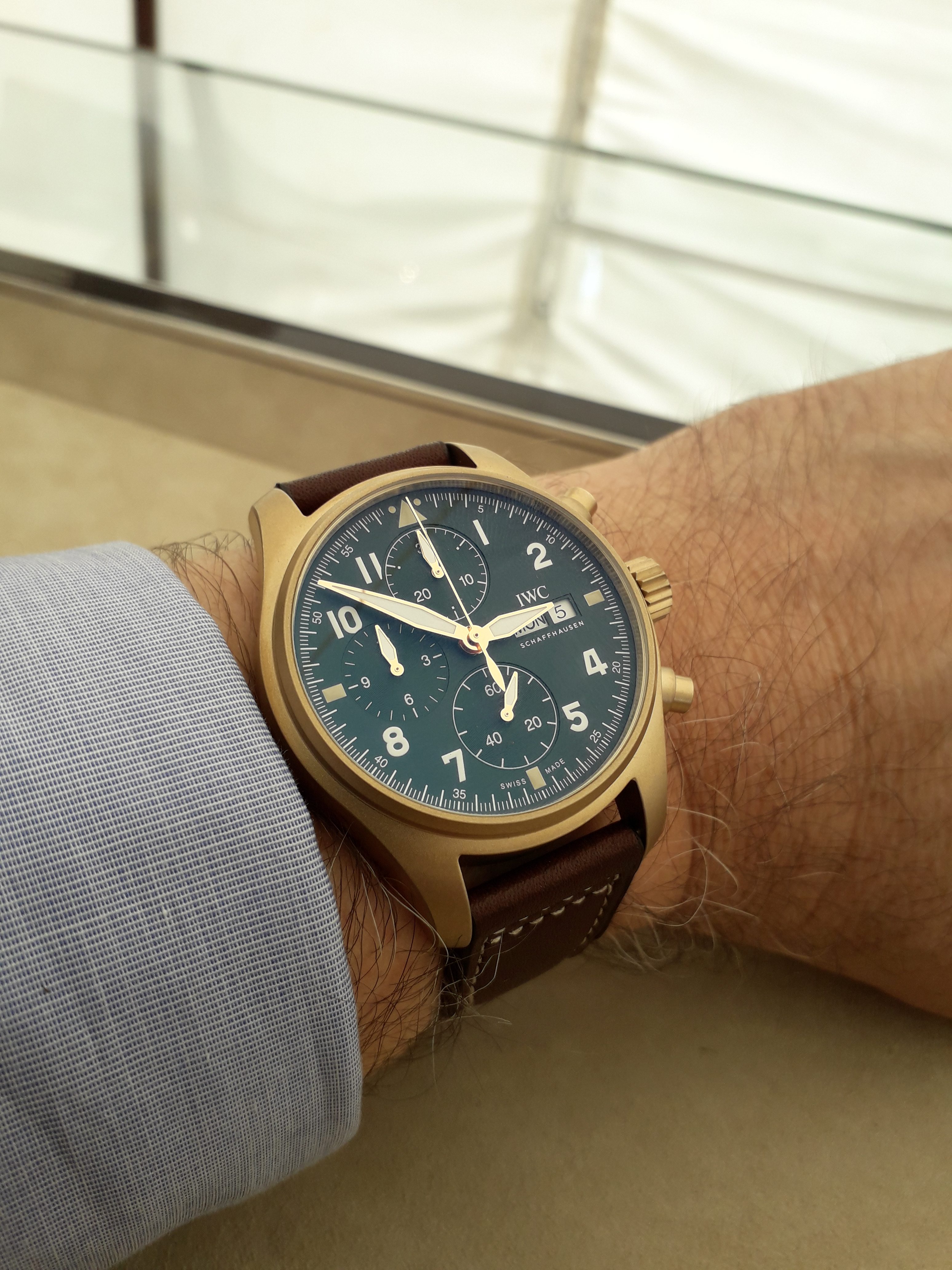
The contrast of the case and dark green dial just works. Yes, rightly it has a military flavour to it, but also a bit dressy too with those white hands edged in gold. The day/date window, now in white with black script, also compliments this. The bronze case is just so subtle – with a light brushed finish. The metallurgical make-up is; copper 86%, Aluminium 10% and Iron 4%, and this makes for a pretty tough structure and will probably not patina too much and is an aspect I prefer. The sizing – width at 41mm, height 15.3mm (but by my reckoning the latter is more like 14mm) and weight are pretty much fine – well for me at least. The aesthetics are greatly complimented by the sturdy leather strap with white stitching, all secured by a conventional pin buckle in bronze too. The strap colour (I would call dark saddle tan) with the leather works 100%. The green Tex strap (available on the steel version) would also work and probably should be offered as well.
The watch contains the newish in-house 69380 calibre. There are some technical improvements over the superseded calibre 79320, but in terms of the power reserve at 46 hrs, only a marginal gain, and this is perhaps the one disappointment of the whole package. Surely a new calibre should be a leap ahead of an old one, rather than a step? Water resistance is to 6 bar. Lastly, the case back is solid and engraved with a Spitfire.
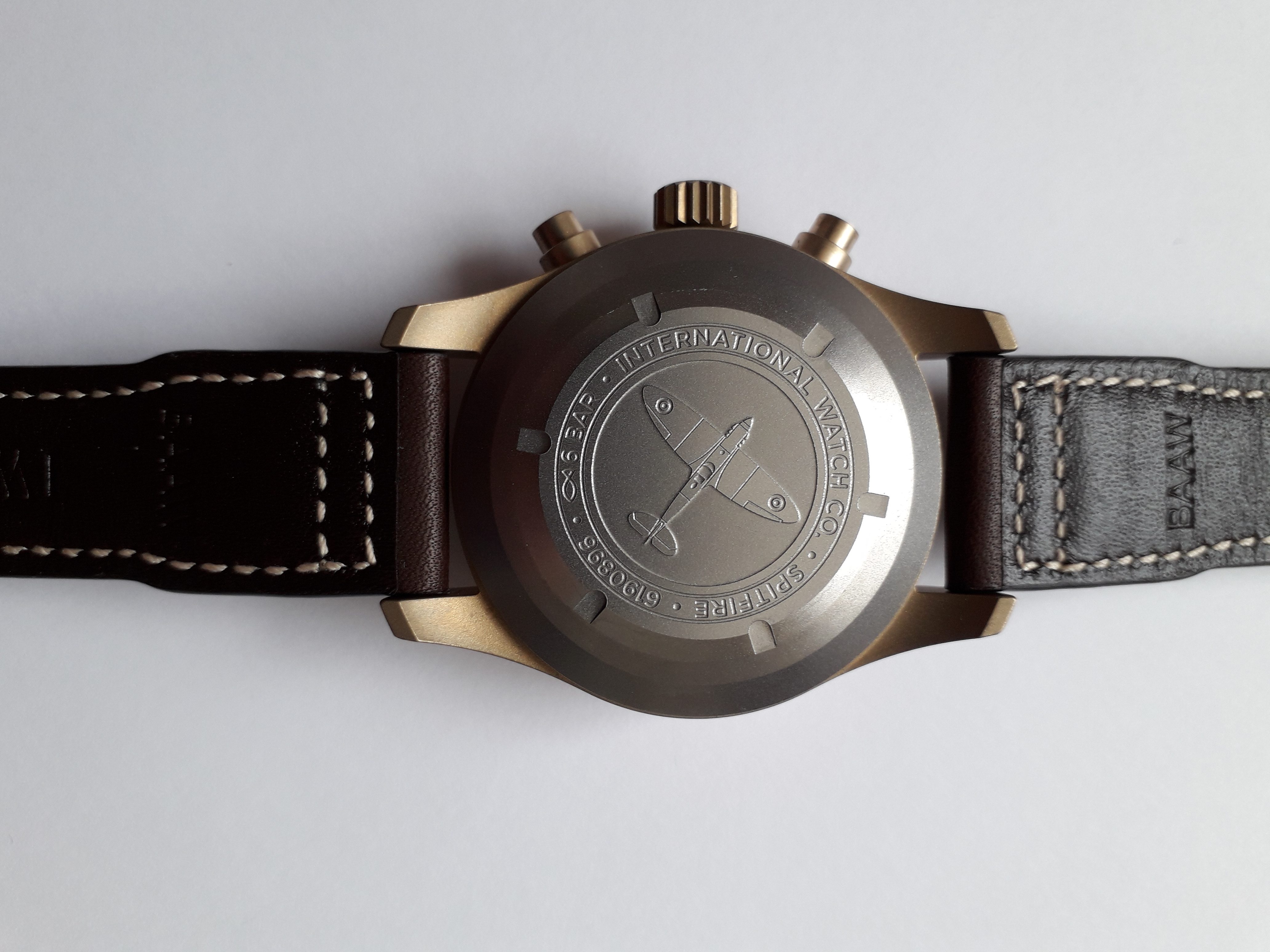
Conclusion
It will come as no earth-shattering surprise that I rate IWC chronographs highly, and in particular now this model. The sizing aspects are just right. The bronze case/green dial/white hands are great, and all info is super readable. The lume at night is more than adequate. Accuracy and winding (manual or left on auto) is flawless – just a pity about that average power reserve. The strap, is as mentioned before, just fine. So, I feel this is an iconic watch and at some £5,690 is fairly priced – and not a huge premium over the steel version at £5,190. Did I acquire one on the day? Well, you might think that but I could not possibly comment!!
Rating 4.5/5 (would have been a 5 but for the power aspect)
Some extra titbits
Spitfire Simulator
On my way out of the event I popped into The Boultbee Flight Academy to pick up a nice green commemorative polo shirt (one button having been made from some scrap aluminium from the plane), but also to find Richard Banks. I met Richard at the first event when Steve kindly facilitated an impromptu sample of their Spitfire simulator – mainly built from original components. Richard is the guy who designed it and importantly devised the way to link the old analogue instruments, and controls, to a computer. This all then translates into movement and thus the sensation of actually flying. In fact, so realistic is it, that independent tests by contemporary Spitfire pilots have given a 98% authenticity score! Richard is an electrical wizz, who after leaving the Royal Navy after a long career of looking after the electrics on nuclear submarines, started his own aircraft simulation company – Airtech Simulation (www.airtechsimulation.co.uk). His main product is the Spitfire simulator and he has clients all over the world. Naturally such kit does not come cheap with a base of some £350,000, and somewhat more with genuine Spitfire parts. That said, I guess somewhat safer and cheaper than using and possibly crashing a real plane worth millions!
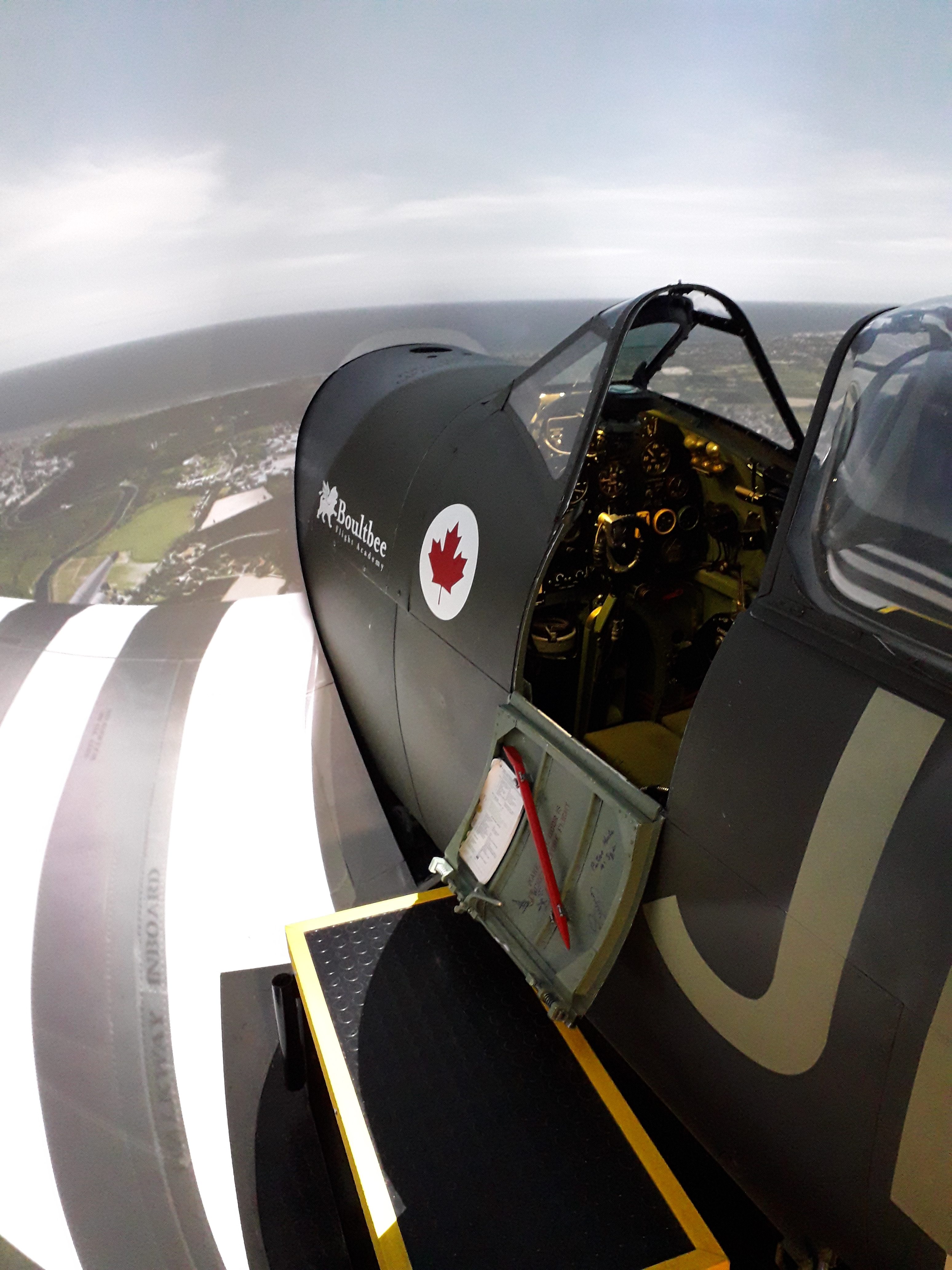
I have a plan with Rich to possibly do a more in-depth article on this fascinating piece of machinery – one reason being that whilst my son had a go I did not due to time constraints. This needs to be remedied! I intend putting the article in the Luxury section as, well, it is the most expensive virtual “toy” I know! Of course it is not a toy, but a seriously useful and ingenious bit of kit – but you know what I mean.
BMW Alpina B10 V8s
Lastly, but of interest I feel, is an occurrence in the Goodwood Hotel car park that evening. I was having a crafty cigar after dinner and was studying a variety of quite tasty machines parked up, when I came across a 5 Series BMW. Not just any 5 Series, but an Alpina B10 and one of the fastest production four door saloons going.
Externally the car is identifiable to its M5 sibling by; Alpina wheels, subtle boot spoiler, side decals and discreet script. I was now peering inside the car very closely, when the owner appeared (probably suspicious of my activity) and we got chatting. It was a 2003 model and he had owned it a few years and was very happy with it. He then suggested having a closer look inside. I was interested to see the further changes Alpina made – seats, steering wheel, pedals, trim and also illuminated tread plates. The owner did not actually realise these were illuminated until I opened a rear door and saw a blue flicker. I looked closer and said to him I thought these were light panels. No way! So I tapped it and bingo it came on. Needless to say that is another small (and maybe costly) job for him to investigate.
The owner was chuffed about a new discovery and said we should go for a spin. Well, the roads around the hotel are usefully long and straight and just as well. We turned out of the hotel gate and just out of sight then he floored it. Needless to say I think it was the fastest road car I have ever been in, and am so pleased the ticker held out! The acceleration was just incredible and relentless – on and on………….. The handling was rock solid and ride comfort pretty good – bearing in mind the lowered suspension and meaty skins all around. It was a fantastic car and in super condition for its age and I am very grateful to the owner for his generosity. Alas, I never got his name, or a pic due to the evening light.
Some Specs
Engine: 4.8L V8
Power: 375 bhp
Torque: 376 lb/ft
0-60: 5.4 seconds (but I have been informed that Alpina underestimate)
Top speed: 170 (governed)
Photos: The Writer and Robert Dennis

